|
|
|
Sort Order |
|
|
|
Items / Page
|
|
|
|
|
|
|
| Srl | Item |
| 1 |
ID:
087480
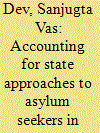

|
|
|
|
|
| Publication |
2009.
|
| Summary/Abstract |
This article uses the case studies of Australia and Malaysia to examine how diverse states in the Asia-Pacific region approach asylum seekers in practice and in discourse. Using a social constructionist approach to identity, the article highlights how governments in each country have grappled with "irregular" migration and the challenges it poses for national identity through processes of "othering" and "exclusion." This comparison shows that the process of excluding asylum seekers on the basis of identity is not a Western phenomenon, but one extending to countries across the region.
|
|
|
|
|
|
|
|
|
|
|
|
|
|
|
|
| 2 |
ID:
152104
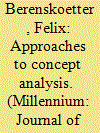

|
|
|
|
|
| Summary/Abstract |
This article takes as its point of departure Stefano Guzzini’s recent call for ‘ontological theorizing’ as a reflexive engagement with central concepts. In an attempt to advance this agenda, the article presents an accessible overview of different approaches to concept analysis to stake out the field for a discussion of what ontological theorising might entail. The article advances the notion of concepts as ‘basic’ and lays out the parameters through which they obtain meaning, followed by a discussion of three approaches, which tackle the multifaceted nature of basic concepts within and across different contexts. These approaches are labelled ‘historical’, ‘scientific’ and ‘political(critical)’ and presented through the work of Reinhart Koselleck, Giovanni Sartori and Michel Foucault, respectively. The article notes that concept analysis, as discussed here, stands in tension with modern forms of theory building yet is a creative source for theorising that accepts the unstable, political and context-bound nature of ontology.
|
|
|
|
|
|
|
|
|
|
|
|
|
|
|
|
| 3 |
ID:
178910
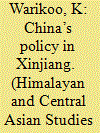

|
|
|
| 4 |
ID:
071219
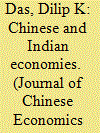

|
|
|
|
|
| Publication |
2006.
|
| Summary/Abstract |
Both China and India were noted for their prowess and prosperity in the remote past, but in the recent past they went into a precipitous decline and became marginal economies, known for large impoverished masses and economic stagnation. Early in the 21st century, China and India are once again being seen as two emerging economic powers of the global economy. The closing decades of the 20th century were remarkable for both the economies. China in particular turned in a stellar economic performance. In the beginning of the 21st century, it was even being seen as the economic super power of the future. It has emerged as a low-cost manufacturing juggernaut invading global markets in a sizeable array of products, with a high and rapidly rising level merchandise exports and imports. In comparison, India's post-1991 growth performance has shown improvement. Although its success in the services sector exports is noteworthy, its economic performance did not match that of China. The economic weight of China and its integration into the global economy is going to continue to increase, and India could follow suit. This article compares and contrasts the two emerging-market economies of Asia, their soaring global significance and global integration and draws policy related lessons from it.
|
|
|
|
|
|
|
|
|
|
|
|
|
|
|
|
| 5 |
ID:
064881
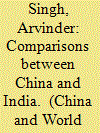

|
|
|
|
|
| Publication |
May-Jun 2005.
|
|
|
|
|
|
|
|
|
|
|
|
|
|
|
|
| 6 |
ID:
140838
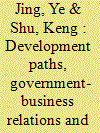

|
|
|
|
|
| Summary/Abstract |
Faced with the rising threat of social instability, the central government in China has launched the rebuilding of social security system since 2002. Local governments, especially city- and county-level governments, are the principal agents implementing this ambitious policy initiative. However, the achievements in establishing social security system vary significantly, even among locales in the same province. In order to identify the factors causing divergence of outcomes, this article compares two similar county-level cities with different social security system performances. Through extensive interviews with key actors, the authors found that the development of local social security system is highly related to the nature of the relationship between local governments and local businesses which is shaped by specific economic development paths. This finding sheds light on the rationale of local governments’ selective implementation of central policies, and why social security systems in some localities but not others may “race to the bottom” in the competition for capital.
|
|
|
|
|
|
|
|
|
|
|
|
|
|
|
|
| 7 |
ID:
124369
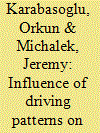

|
|
|
|
|
| Publication |
2013.
|
| Summary/Abstract |
We compare the potential of hybrid, extended-range plug-in hybrid, and battery electric vehicles to reduce lifetime cost and life cycle greenhouse gas emissions under various scenarios and simulated driving conditions. We find that driving conditions affect economic and environmental benefits of electrified vehicles substantially: Under the urban NYC driving cycle, hybrid and plug-in vehicles can cut life cycle emissions by 60% and reduce costs up to 20% relative to conventional vehicles (CVs). In contrast, under highway test conditions (HWFET) electrified vehicles offer marginal emissions reductions at higher costs. NYC conditions with frequent stops triple life cycle emissions and increase costs of conventional vehicles by 30%, while aggressive driving (US06) reduces the all-electric range of plug-in vehicles by up to 45% compared to milder test cycles (like HWFET). Vehicle window stickers, fuel economy standards, and life cycle studies using average lab-test vehicle efficiency estimates are therefore incomplete: (1) driver heterogeneity matters, and efforts to encourage adoption of hybrid and plug-in vehicles will have greater impact if targeted to urban drivers vs. highway drivers; and (2) electrified vehicles perform better on some drive cycles than others, so non-representative tests can bias consumer perception and regulation of alternative technologies. We discuss policy implications.
|
|
|
|
|
|
|
|
|
|
|
|
|
|
|
|
| 8 |
ID:
127079


|
|
|
|
|
| Publication |
2013.
|
| Summary/Abstract |
With diverse histories and attitudes toward risk-taking, different financial systems have a common aim: ensuring financial stability and efficiency within a geographical region. But differences exist between various financial systems as a result of their evolution and adaptation to their surrounding environment. This paper aims to analyze the incentive and sanction mechanisms of the Islamic mode of banking and the Grameen Bank model of microcredit in Bangladesh, and how they help ensure their financial stability and efficiency. We challenge the conventional explanations of their success. We point out that the informal sanction mechanisms embedded in the two modes of financial intermediation - avoiding non-compliance with Islamic Shari'ah (revealed divine law) in the case of Islamic banking, and kinship-based groupings or gushtis in the case of microcredit - play important roles in lowering the transaction costs of screening and enforcing contracts. We also point out how bank rent opportunity - the promised return from non-participatory financing and a high spread supported through low-cost funds provided by donor agencies and compulsory savings - is captured in each of the two modes, playing a further important role in maintaining their franchise values, given the specificities of the Bangladeshi financial context.
|
|
|
|
|
|
|
|
|
|
|
|
|
|
|
|
| 9 |
ID:
085331
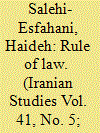

|
|
|
|
|
| Publication |
2008.
|
| Summary/Abstract |
The ancient Persian empires are denoted as despotic, practicing arbitrary rule while Greece, Persia's archrival during the sixth to fourth century BC, exercised rule of law. This paper uses a contract theory framework to analyze some of the geographical and environmental underpinnings of the existence of rule of law in the city-states of ancient Greece and its absence in Persia. I discuss the role of geographical conditions of land (open plains versus mountains), population pressure, proximity to the sea and form of trade (overland versus overseas) as factors conducive to rule of law in the city-states of ancient Greece and to despotism in ancient Persia. Specifically, the role of trade via land in Persia prior to the fifth century BC is compared to the role of sea trade (alongside with piracy) in ancient Greece. I argue that in ancient Persia monarchs could tax or expropriate much of the gains from overland trade, preventing the accumulation of an independent form of wealth by merchants. In Greece, sea trade alongside the practice of piracy led to gains from trade that could not be easily expropriated by the monarchs and acted as a balancing force vis- -vis the power of the monarchs, creating a basis for rule of law in the Greek city-states.
|
|
|
|
|
|
|
|
|
|
|
|
|
|
|
|
| 10 |
ID:
133788


|
|
|
|
|
| Publication |
2014.
|
| Summary/Abstract |
At the contested analytic core of this special issue of Pacific Affairs lie two different ways of linking enlargement to assessment. Southeast Asian studies, as a spatially limited instance of Area Studies (AS), are focused wholly or mainly on one part of the world and on phenomena occurring in it or directly relevant to it. In contrast, no toponym constrains the scope of Comparative Area Studies (CAS). The editors of this issue recommend the expansion of AS into CAS. Does a convincing case for such enlargement from AS to CAS require only a nominal or taxonomic expansion-subsuming more space in which comparisons can be made-without necessarily privileging one method over another? Or does the case for CAS presuppose a negative assessment of AS as less hospitable to systematiccomparison, and thus methodologically inferior to CAS? The discussion that follows is not epistemologically agnostic. Nor is it promiscuous as to methods. But it emphasizes the need for methodological pluralism and the virtues of openness and ecumenism thereby implied. A segue from AS to CAS will multiply the opportunities for comparison along with the scale and complexity of the items, changes, and interactions that could be compared. It may be tempting to simplify all these empirics by filtering them through the lens and format of a systematically reductive technique. It would however be ironic if that understandable temptation were to reproduce in method the narrowness of scope that warranted CAS in the first place. If and as scholars expand their analytic horizons in the hope of making more sense of a globalizing world, the notion of unwanted or uncontrolled comparison may seem less demonic-a "spectral" invitation to chaos-than creative-an intellectually refreshing way of thinking outside of any box whose efficacy depends disproportionally on closure.
|
|
|
|
|
|
|
|
|
|
|
|
|
|
|
|
|
|
|
|
|